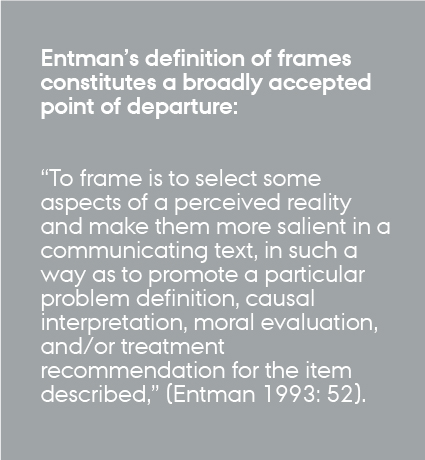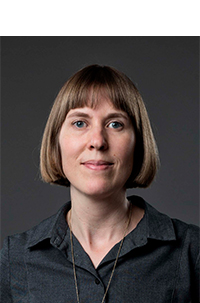A new study from Aarhus BSS explores how interest groups frame their messages in the media. This may help us understand how our perception of topics such as state education grants or the teachers’ working hours is affected by the words and frames used by the groups. Ultimately, this may allow us to make more informed decisions.

It makes a world of difference whether students receive ‘coffee shop money’ or financial assistance. When we use the term ‘coffee shop money’, the state education grant becomes an unnecessary luxury payment made out to spoiled youngsters living at home. However, this is the same as calling the early retirement pension a ‘golf supplement’ according to Lisbeth Simonsen, a member of the former state education grant committee. She made the comment in 2011 when the topic of state education grants for students living at home was once again high on the media agenda.
“Framing affects our way of perceiving the world and thus also our attitudes. Naturally, well-documented facts are essential, but a well-chosen frame has proven to be an effective tool for influencing public debate. The reason is that framing generates images in our minds and influences how we feel about specific cases or people. It also affects how likely we are to support a given case or person. It’s much easier to cut down on state education grants when it is referred to as coffee shop money rather than financial assistance. In this way, getting people to use this kind of expression is a brilliant strategy,” says Professor Anne Binderkrantz from the Department of Political Science at Aarhus BSS.
Various types of frames
Naturally, interest groups are well aware that frames affect our perception of certain topics. In a new study, Anne Binderkrantz explores how interest groups use frames in the media to promote their own viewpoints and push the political process in their preferred direction while maintaining membership support.
The data used in the study is a mapping of the interest group coverage in two Danish and two UK newspapers (Jyllands-Posten and Politiken as well as The Daily Telegraph and The Guardian). The questions asked were: Which type of group are we dealing with (economic group or public interest group)? And which type of argumentation does the group apply (does it focus on the members, the economy, society at large or other groups)? For example: if the Danish Union of Teachers makes a statement in a news story about the discussion of the teachers’ salary in the school reform will the union focus on the harm it will do to teachers or the harm it will do to the economy because children will have poorer education?
“It is often argued that interest groups will appeal to as wide a group as possible when attempting to sell their messages. In other words, when childcare workers argue in favour of increasing the staffing, they should not focus on how hard it is to be a childcare worker, but rather on how hard it is to be a child in childcare. However, my analysis shows that interest groups use many different types of frames and arguments when they appear in the media. This means that they do not appeal only to their members or to society at large,” says Binderkrantz, who believes that this is a good thing.
“In my opinion, you shouldn’t necessarily have to force your arguments into a framework that may become artificial if everything is described in terms of benefitting the public at large. It may also be a good idea to reflect a balance between specific groups who either stand to be hit or to benefit from something,” she says.

"It may also be a good idea to reflect a balance between specific groups who either stand to be hit or to benefit from something.”
Anne Binderkrantz - Professor, Department of Political Science, Aarhus BSS
Difference between countries, groups and policy areas
After an overall mapping, the data was divided into three separate analyses of what variables might influence the groups’ choice of arguments and frames; country differences, types of groups and policy areas.
Let us start with country differences: When comparing Denmark and the UK, it turns out that Danish interest groups are more likely than UK groups to appeal to the interest of their members.
“I’m actually somewhat surprised that membership interests play such a significant role in Denmark,” says Binderkrantz. In her opinion, the difference is most likely due to the Danish tradition of involving interest groups in society.
“As the study only concerns two countries, there may of course be lots of other explanations for the differences. However, there’s no doubt that a key factor is Denmark’s well-established organisational system in which all employees are represented by a union and all employers by a trade organisation. In Denmark, there is also a tradition for civil servants and politicians to listen to the interest groups based on their representation of specific member groups,” she says.
Danes are thus more to likely to accept that the Danish Union of Teachers emphasises the conditions of the teachers as these are the people represented by the group. However, it is a different story in the UK. Here interest groups and trade organisations are not as systematically organised. Due to a much more fragmented organisational landscape, UK groups and organisations compete a lot more for members as well as for political attention as this is not a given.
“This means that groups and organisations are forced to constantly appeal to broader societal issues to get their message across,” says Binderkrantz.
The graph shows the distribution between the different types of frames in news stories. The colours illustrate the proportion of frames where the groups primarily focus on the consequences for: 1) their own members, 2) other groups in society, 3) the economy and 4) other public interests such as human rights or the environment. The four columns show economic groups and citizen groups in Denmark and the UK respectively. GRAPHIC: Simon Andersen Nørredam
Some organisations more legitimate to support than others
Apart from the country differences, the study also shows that the frames used differ depending on what type of group we are dealing with.
In both countries, economic groups that cover specific sectors (e.g. Danish Industry) mostly use frames that appeal to the interest of their members.
The opposite is the case for citizen groups, i.e. groups that are not hinged on labour market benefits (e.g. the Danish Society for Nature Conservation, the DaneAge Organisation or patient groups). These will often use frames that appeal to the broader interests in society.
“In this connection, we can also see that some groups are more legitimate to support than others. For example, it’s easy for the DaneAge Organisation to talk about the people they represent as everyone can imagine themselves as an elderly person. However, for a group representing chemical-producing companies it will be somewhat harder to achieve the same kind of public support,” Binderkrantz explains.
When it comes to policy areas, the study shows that interest groups most often use membership frames in news stories/policy areas that concern the economic regulation of specific sectors in business and industry - e.g. in the discussion of new work environment rules or of how to administer agricultural subsidiaries.
“In contrast, interest groups appeal much more broadly in areas such as law or immigration where more general regulation is at stake,” says Binderkrantz.
Frames affect how we perceive each other
According to Binderkrantz, citizens or politicians may use this knowledge when they follow or participate in everyday debates that involve a plethora of stakeholders all trying to gain influence and affect the perception and outcome of a specific case.
“Frames are strategic weapons that citizens and politicians need to be aware of to be able to assess political communication per se - not only when it comes to interest groups trying to sell their message, but in general as well. What are the different actors focusing on? Who are they talking to? And how does this affect my perception of the specific case?” she says.
For citizens, being aware of frames is relevant to be able to dig a bit deeper when reading the newspaper and being presented with arguments. What are the interest groups trying to achieve? Are they appealing to the emotions of their members or to wider public interests? And how does this affect who or what you are likely to support yourself? For politicians, it is important to remember that the way in which you present your arguments will have a significant impact on which people and groups end up having the final say.
“The different frames affect how we perceive our fellow citizens. Knowing more about the underlying mechanisms makes us better at recognising the strategies used and thus also the causal claims put forward by the different frames. In this way, we become better at seeing through the communication and subsequently assessing our own attitudes. Ultimately, this allows us to make more informed decisions,” Binderkrantz concludes.
Source: Anne Skorkjær Binderkrantz (2019): Interest group framing in Denmark and the UK: membership representation or public appeal?, Journal of European Public Policy. |
|---|